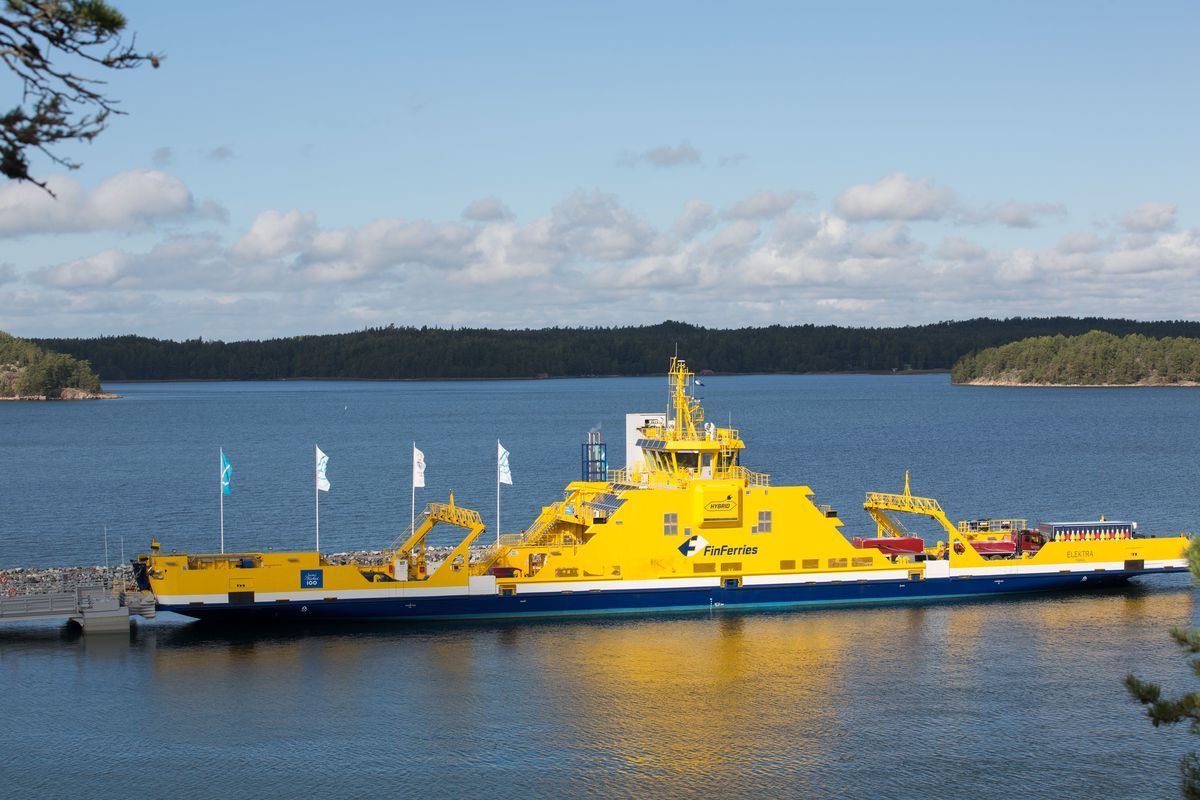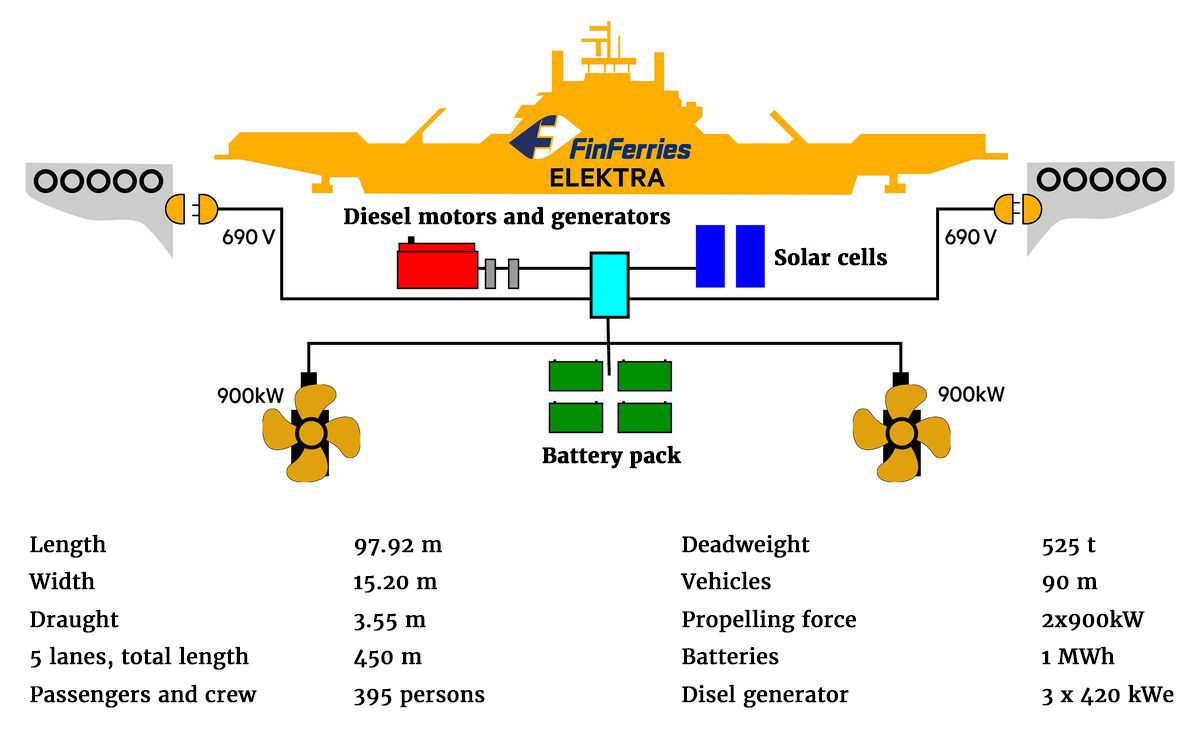Elektra always makes it through the Turku archipelago
The Elektra, the electric hybrid ferry which runs from Parainen and Nauvo, is as unique as the archipelago environment. Over the past year, the ship has sailed on through autumn storms and wintry icy conditions.
At 6 am, the Parainen ferry is quiet. Just a few metallic clangs break the silence of the archipelago, as the ramp of the Elektra ferry rises and it starts its journey to Nauvo, just over 1.5 km away, with a few early bird drivers on board.
“Let’s take it a little more slowly than normal, so we can leave that family of ducks in peace. This vessel is so quiet that the birds won’t even notice us. Sometimes I’m tempted to just toot the horn,” laughed captain Tuumas Mikkola.
The reason why the Elektra is so quiet can be found below decks, in the engine room. Instead of a traditional diesel engine, the ferry runs on massive batteries, which are quickly charged on land when the vessel docks. The Elektra can run on diesel, too, but it is only used to charge the battery packs and power the vessel if charging on land doesn't work for some reason.
“In the first year, the weather was very changeable, so we could see that the technology worked. Storms, ice and freezing temperatures don’t stop this ship, unless the weather conditions are really impossible,” said Mikkola, revving the engine with a device that looks like a game controller. The pace picks up noticeably, but soundlessly, apart from a gentle splash. On the outside deck too, you can hold a conversation without raising your voice.
“The ride is really smooth. Even your coffee doesn’t spill,” says Mikkola, pointing to his mug.

More than half a million cars a year use Finland's busiest ferry route. The electric ferry that navigates the natural seascape is quiet and environmentally friendly.
Silence is golden
The command bridge of the Elektra gives you a 360-degree view of the beautiful, unique and fragile archipelago environment. Mikkola steers the ferry between Parainen and Nauvo more than 70 times a day.
Each single trip takes about ten minutes. This is Finland's busiest ferry route, used by about 600,000 vehicles a year. The Elektra can take 90 at a time. There are about 9,000 summer cottages in the Parainen area alone.
“This is like the Tesla of the Turku archipelago: it runs silently, accelerates briskly and produces zero emissions. On board, you can hear all the sounds of nature,” said Mikkola. Passengers are full of praise for the ferry’s silence, performance, and significantly larger capacity. Many people also like that fact that the traditional smell of diesel doesn't fill the air, as the captain stressed. “Now we are used to this, we really don’t miss the diesel engine.”
A bold leap forward
Mats Rosin, the CEO of FinFerries, which manages ferries and ferry traffic all over Finland, explained that they looked at a range of options for the Parainen-Nauvo route. They were especially keen to learn from the Norwegian experience of electric ferries.
“We took the bold decision to go for a hybrid, although you won’t find a electric-diesel combination like this anywhere else,” said Rosin.
Another key criterion was guaranteed service. The service has to run whatever the weather – even in the middle of a power cut. Other important factors included environmental standards and the need to reduce CO2 emissions. On the Elektra’s route, CO2 emissions have more than halved compared to diesel alone.
The Elektra was built in the Polish shipyard, CRIST S.A., in spring 2017. Siemens took responsibility for the overall operation and the ferry’s modern technology.
“For a small shipping company like ours, having someone to take on the project as a whole was very important. Our goal is to reduce overall ferry emissions by 25 percent, which means gradual electrification of the whole fleet. Siemens is an important partner, enabling us to reach this target.” said Rosin.
Last spring, the Elektra won the international Ship of the Year award at the Sulphur Cap 2020 Conference in Amsterdam.
“In the past, I could take it easy at international seminars and conferences. Now everyone wants to find out more about the Elektra,” said Rosin.

Ampere – a role model
Siemens sales manager, David M. Moilanen, was closely involved in the Elektra project. The Ampere, a fully electric ferry that started operating in Norway a few years earlier, was a key role model for this vessel.
“Electricity and hybrids are becoming a regular part of road and rail traffic, and now this change is coming to water transport, too,” said Moilanen.
Rapidly evolving battery and charging technology have enabled great leaps forward. The undeniable advantages of electric motors are reliability, low maintenance requirements, zero emissions, and silence.
“In a natural environment, the quietness has become more important than ever before. We have enough noise all around us as it is,” Moilainen said.
Like the Ampere, the Elektra showcases the skills of the Norwegian team at Siemens. The hybrid ferry utilises IoT technologies and Siemens’ open, cloud-based MindSphere-IoT operating system, which collects real-time data about how ferry runs, and can anticipate maintenance needs.
The shore of Nauvo is still half a kilometre away, but Tuumas Mikkola lets the ferry run in neutral for the rest of the trip. Yet again, this saves a little energy – and the environment. As they disembark after a smooth trip, regular passengers wave their thanks to Elektra’s crew. Then loading starts, and the waiting cars board. Mikkola has the last word.
“This ship is a real skipper's pipe dream – brimming with state-of-the-art technology. Next time I get a new car, I might go for an electric one.”